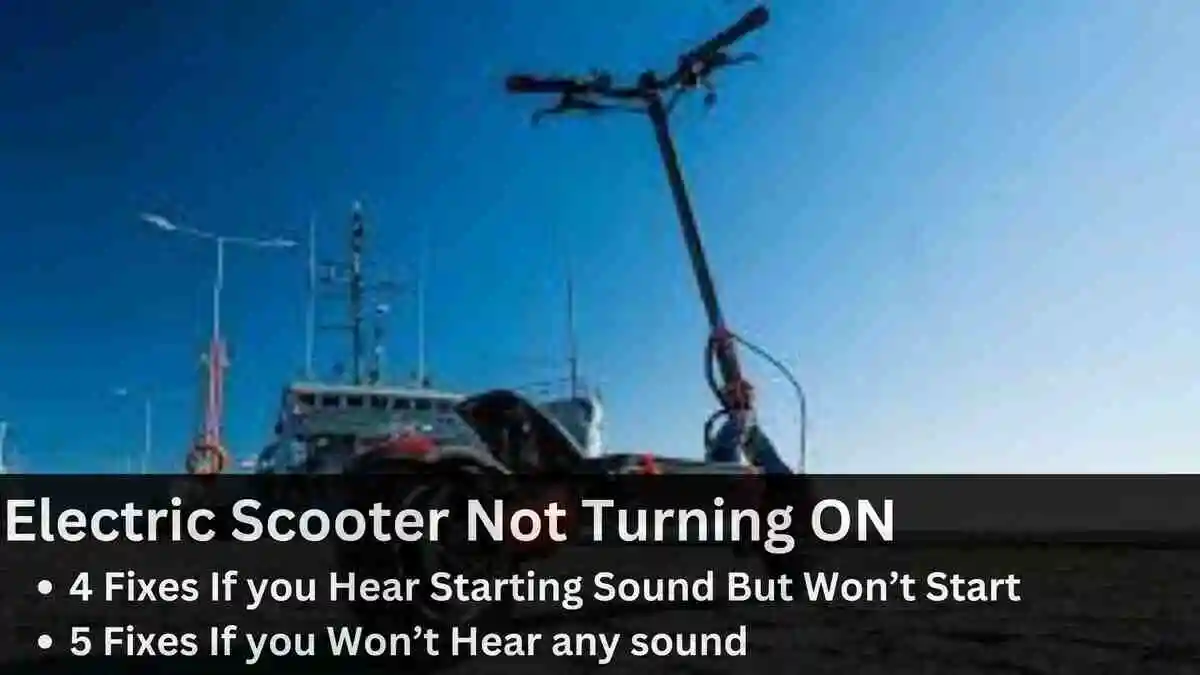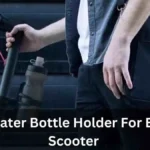Electric scooters have become a popular mode of transportation, offering convenience and eco-friendliness. However, they are not immune to issues, such as electric scooter not turning on, especially when exposed to water or rain. Water damage can wreak havoc on an electric scooter, affecting various components like the battery, controller, motor, wiring, and more. So why won’t my electric scooter turn on.
In this guide, we will explore why is my electric scooter not turning on and how water damage can affect your electric scooter and provide step-by-step instructions on how to fix it.
Electric Scooter Sounds While Turning ON But Won’t Turn On:
If your electric scooter exhibits sounds during the startup process but fails to power on and in some case it turns off while riding this issue may stem from various underlying factors. Below, we present potential causes and corresponding remedies.
1. Faulty starter gear:
When attempting to initiate the electric scooter, an unusual whirring noise may emanate, possibly due to the improper seating of the starter gear or insufficient electrical signal.
To resolve this, examine the starter gear and ensure it is correctly positioned. If it is misaligned, you may need to consider replacing it.
2. Flawed starter relay:
If a clicking sound is audible during the startup process, it may be attributed to a defective starter relay. To address this, inspect the starter relay and replace it if deemed necessary.
3. Malfunctioning controller:
In cases where the controller produces a clicking sound but the motor remains inactive, the issue could arise from an aged or worn-out battery pack that experiences excessive voltage drop under load.
You can assess the battery pack’s voltage with the power switch turned off and then, while monitoring the voltage level, activate the power switch and twist the throttle.
Should the battery pack voltage drop to 23 volts or lower, a replacement of the battery pack becomes necessary. If the battery pack passes the load test, the controller may be faulty, requiring replacement.
4. Defective throttle:
If your electric scooter emits sounds during startup but refuses to power on, a malfunctioning throttle may be the culprit. To assess the throttle’s functionality, rotate it and observe if the lights, display, and speed indicators activate.
In the event the display remains unresponsive, the problem might be attributed to a poor connection between the throttle and controller.
Conduct a thorough examination of the wiring connections between the throttle and controller, and replace any damaged components accordingly.
Why Is My Electric Scooter Not Turning ON (No Sound)
1. Wiring Damage:
Identification and Assessment: Water infiltration poses a significant risk to the wiring system of your electric scooter, potentially leading to electrical malfunctions. To address wiring issues effectively:
Examine Wiring Components: Thoroughly inspect the wiring harness and components for any signs of damage, such as frayed insulation, exposed wires, or loose connections. Pay close attention to areas prone to water exposure, such as the underside of the scooter or near the battery compartment. If any wiring issues are detected, they should be promptly addressed to prevent further damage.
Fuse and Circuit Breaker Inspection: Using a multimeter, assess the condition of the fuse or circuit breaker to ensure proper functionality. Loose connections or damage to these components can disrupt the electrical flow, resulting in the scooter’s failure to turn on. If any faults are detected, consider replacing the affected fuse or circuit breaker with a compatible unit.
Repair or Replacement: Attempt to rectify wiring issues by following online tutorials or manufacturer guidelines. However, if the damage is extensive or beyond repair, it may be necessary to replace the affected wiring components entirely. In such cases, seek assistance from a professional technician to ensure proper installation and functionality.
2. Battery Damage:
Identification and Diagnosis: Water exposure can compromise the integrity of the scooter’s battery, leading to malfunctions and reduced performance. To address battery-related issues effectively:
Inspect Charger Port and Connections: Examine the charger port and associated wiring for any signs of damage, including loose, frayed, or corroded connections. Attempt to charge the scooter using a different outlet to verify the functionality of the charger port and observe the indicator lights to confirm charging activity.
Battery Voltage Testing: Utilize a voltmeter to measure the voltage of the battery and assess its overall health and charge status. A depleted or damaged battery can significantly impact the scooter’s ability to power on and function properly.
Replacement Consideration: If the battery exhibits signs of damage or fails to hold a charge effectively, it may be necessary to replace it with a new, compatible unit. Dispose of the old battery responsibly in accordance with local regulations and guidelines.
3. Controller Damage:
Identification and Resolution: Water ingress can compromise the functionality of the scooter’s controller, resulting in erratic behavior or failure to operate. To address controller-related issues:
Throttle and Controller Connection Check: Inspect the wiring connections between the throttle and controller for any signs of damage or loose connections. Ensure that the throttle is communicating effectively with the controller to regulate power flow accurately.
Overheating Assessment: Examine the throttle and controller for evidence of overheating, such as melted wires or components. Overheating can indicate underlying issues with the electrical system and may require replacement of the affected components to prevent further damage.
Professional Intervention: If the controller is deemed faulty or damaged beyond repair, consider seeking assistance from a professional technician to diagnose and resolve the issue effectively. Professional expertise ensures proper troubleshooting and repair of complex electrical components.
4. Motor Damage:
Identification and Evaluation: Water exposure can adversely affect the scooter’s motor, resulting in diminished performance or complete failure. To address motor-related issues:
Visual Inspection: Carefully inspect the motor for any visible signs of water damage, such as rust, corrosion, or electrical shorts. These indicators may suggest underlying issues that require immediate attention and potential replacement of the motor assembly.
Replacement Consideration: If the motor exhibits significant damage or fails to function properly despite troubleshooting efforts, it may be necessary to replace it with a new, compatible unit. Professional assistance may be required to ensure proper installation and alignment with the scooter’s drivetrain system.
5. Throttle Issues:
Diagnosis and Resolution: The throttle plays a crucial role in regulating the power output of the scooter, and any malfunctions can impair its functionality. To troubleshoot throttle-related issues effectively:
Functionality Testing: Test the throttle by twisting it and observing its response, including the activation of indicator lights and speed engagement. Ensure that the throttle is communicating effectively with the controller to regulate power flow accurately.
Wiring Inspection: Inspect the wiring connections between the throttle and controller for any signs of damage, corrosion, or loose connections. Address any issues promptly to restore proper communication between the throttle and controller.
Replacement Consideration: If the throttle fails to function correctly despite troubleshooting efforts, consider replacing it with a new, compatible unit. Proper calibration and alignment of the throttle are essential to ensure optimal performance and responsiveness.
Conclusion:
Water damage can be a significant headache for electric scooter owners, but with the right knowledge and troubleshooting steps, you can often identify and fix the issues yourself.
However, if you’re not comfortable with DIY repairs, don’t hesitate to seek help from a professional technician who can inspect and repair your electric scooter effectively.
Regular maintenance and protection from the elements can go a long way in preventing water damage and ensuring the longevity of your electric scooter.



